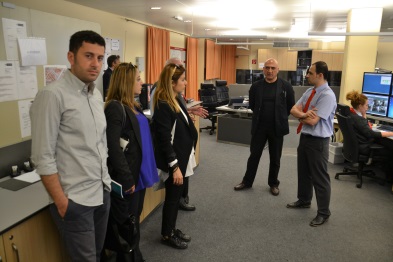Work shadowing
Also known as: Staff exchange, secondment
Work shadowing allows an individual from one city to work alongside, and gain experience on the role of another individual with similar responsibilities in another city, who is usually more experienced. This way they can gain greater insight into that particular work area and improve their own way of working.
It involves one, or sometimes two people from a visiting city spending time with experts in another city working in the same field or on similar projects, observing what they do in their professional role, and how. This facilitates an on-site exchange of expertise through first-hand observation of how things are done elsewhere, providing new ideas for working methods and their application.
Method
- Partner matching: Participants are paired based on their experience levels and learning needs. The aim is to match individuals with similar roles, allowing for the effective exchange of skills and insights.
- Duration: A typical work shadowing stint ranges from a few days to a week, depending on the objectives and depth of learning sought.
- Preparation: Before the actual shadowing, preparatory activities, including online meetings, are carried out to acquaint participants with each other’s working contexts, expectations, and areas of expertise.
- On-site observation: The visiting participant shadows their host, observing their day-to-day work, approaches, and interactions. This direct observation offers a nuanced understanding of working methods, challenges, and solutions in a different setting.
- Engaging with stakeholders: Often, the host arranges meetings with several stakeholders. This offers the visitor a broader perspective, encompassing multiple viewpoints from the host city.
- Documentation: The visiting participant is typically expected to document their observations, insights, and suggestions, culminating in a comprehensive report that encapsulates the lessons from the shadowing experience.
Examples of application
Eurocities’ EU-funded ROCK Project:
-
- Preparation: Detailed preliminary meetings were held online to help participants understand each other’s contexts and set clear objectives for the visit.
- Approach: This project leaned towards the mentor-mentee paradigm, with ‘learning partners’ in the observer role and seasoned professionals demonstrating their expertise.
- Documentation: Post-shadowing, visitors drafted a concise report based on their observations. They were also encouraged to take notes and photographs during their visit, detailing the valuable lessons gleaned.
- Eurocities’ EU-funded CREATE Project:
- Approach: Similar to ROCK, the project employed the mentor-mentee dynamic, facilitating a structured flow of knowledge from the experienced host to the observing visitor. Yet, the project also accommodated mutual knowledge exchanges between cities with comparable experience levels.
It’s worth noting that the work shadowing approach is versatile, and while mentor-mentee dynamics are common, equal exchanges between cities with rich experiences in their domains are also frequent.
Top tips
- Define objectives: Establish clear and concise goals for both parties to align expectations and enhance the learning experience.
- Preparation: Prior familiarisation with each other’s contexts and needs ensures meaningful interactions and exchanges during the visit.
- Open dialogue: Promote an environment where questions and discussions are welcomed, facilitating deeper understanding and learning.
- Diversify interactions: Arrange meetings with a variety of stakeholders to provide a well-rounded perspective and insight into different aspects of the work.
- Document insights: Consistently note observations, reflections, and insights to facilitate future reference and wider organisational learning.
- Be receptive: Both the host and the visitor should be open to receiving and providing constructive feedback for mutual growth and improvement.
- Apply knowledge: Integrate the new lessons into your own work and share them within your organisation to maximise the impact.
- Stay flexible: Be ready to adjust and optimise learning from unexpected situations and alterations in plans.
- Maintain connections: Sustain the professional relationship post-visit for continued learning and resolution of any further queries.
Pros & cons
Pros:
- The possibility to observe, ask and discuss ideas on the spot allows people to gain experience and fresh insights into specific professional roles and the methods employed therein. This can be useful when new tasks are introduced into a professional field or new methods are
- By observing a host city with greater experience and/or in a different institutional setting, the work shadowing method enables people ‘to see behind the curtain’ into a single professional
- Potentially less time-consuming to organise than study visits.
- Meetings are very focused, attracting specialists.
Cons:
- Language barrier is a big obstacle to this type of methodology. Work shadowing worked best when language was the same or the visiting cities spoke the host city’s language. It might work when English is widely spoken in the host and visiting cities (e.g. worked well with German, Swedish and Finnish cities).
Outcomes and impact
For the shadower, this methodology opens up deep insights about other ways of working.
Although a work shadowing visit is usually more focused on the host assisting the visitor, there are many benefits for the host as well as the host can develop his/her own skills further and reflect on his/her day-to-day work. Answering the visitor’s questions and discussing different possibilities might give rise to ideas on how to further develop and improve strategies, projects and/or methods.
Impact
As a result of work shadowing in Sharing Cities, the examples of Lisbon’s internal governance, energy agency and their citizen engagement practices have been very useful for Bordeaux which is using those experiences in its reorganisation.
Pitfalls
Keep groups of visitors very small, otherwise work shadowing visits lose their focus and turn into study visits.
Links


